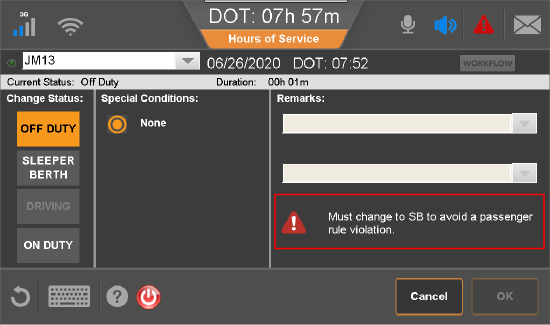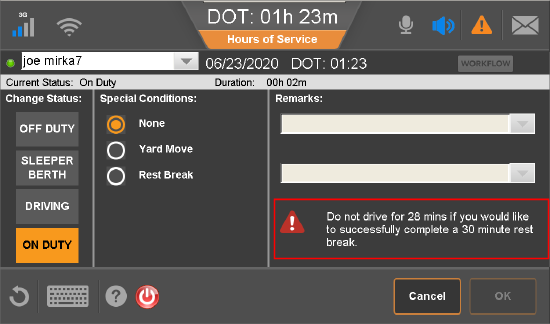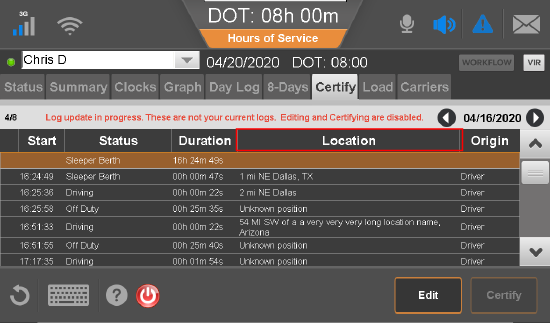IVG Version DA0966RST18 Release Notes
Hardware Requirements and Software Dependencies
This firmware release supports the following and higher MCNs:
- CV90-JC339-1xx, -2xx, -3xx
- CA90-JE045-1xx, -2xx
- CV90-JE045-1xx, -2xx
- CA90-JC339-1xx, -2xx, -3xx
and is composed of the following software:
- PAPI 1.9.1
- VIOP 1.08.02
- WEC2013 OS (OS 61)
Operating System
- Operating system and firmware will now be upgraded in the same install. With this enhancement, the operating system will be updated to the latest version OS61.
- 4G LTE units that use IVG satellite and all DTTS enabled units (UA 108500000 or higher) are compatible with the Microsoft Windows Embedded Compact operating system (WEC2013 OS) OS53 or higher.
Upgrade Procedures
Most upgrades are done over-the-air. The IVG firmware is available for download on the Omnitracs Customer Portal (on the Support page, click Firmware/OS and refer to the Installation and Troubleshooting Guide).
Update Regarding ELD Compliance
Omnitracs will be submitting an update to the ELD certification documentation provided on the FMCSA ELD Website to indicate that IVG DA966RST18 is the minimum ELD-compliant version of the IVG.
The IVG DA966RST18 update includes corrections to ELD functionality that were necessary to comply with the U.S. ELD Mandate. Updating to this version of the IVG is required to maintain an ELD-compliant device. IVG versions previous to version DA966RST18 are no longer considered ELD-compliant.
Please update your devices at your earliest convenience to ensure you are running IVG version DA966RST18.
New Features and Enhancements
Updates to Sleeper Berth
OHOS-1141, OHOS-2257, OHOS-2473, OHOS-2330, OHOS-2256
The new FMCSA rules will affect Sleeper Berth requirements as follows:
- Drivers using U.S. Federal Rules that allow them to split their 10-hour reset will be able to take their required 10 hours of off-duty time in two periods, as long as one off-duty period (whether in or out of the sleeper berth) is at least two hours long and the other involves at least seven consecutive hours spent in the sleeper berth. Neither qualifying period counts against the 14-hour duty clock.
- If the new split sleeper rules are in effect, drivers in the U.S. will be able to check Will Pair SB in the Status tab of the Hours of Service screen so their available hours will be calculated using an optimistic view of available hours and they will be informed when they need to shut down according to sleeper berth regulations.

- The Passenger Rule will allow a co-driver to take a combination of Sleeper Berth time of at least seven consecutive hours and up to three hours riding in the passenger seat of a moving vehicle, either immediately before or after the Sleeper Berth time, amounting to at least 10 consecutive hours.
- While the co-driver is still off-duty, the Change Status screen will remind the driver that the sleeper berth is required.

For drivers in Canada, the system will continue to calculate sleeper berth time based on Canadian sleeper berth regulations.
Rest Break Changes
OHOS-1140, OHOS-2255
Drivers using U.S. Federal rules will be able to take their 30-minute rest break while they are in any duty status other than Drive. In addition, they will only be required to take the rest break after eight cumulative hours of driving.
The qualifying 30-minute rest break can be a combination of any duty status other than Drive. Personal Conveyance and Yard Move will also qualify toward the rest break. On the Change Status screen, when the rest break clock has two hours or less remaining and the driver is not in a Driving status, a warning message will tell drivers how many minutes they have left before they complete their 30-minute rest break.
Note: The modified warning message will not appear until the new FMCSA rules take effect on September 29, 2020. Until then, drivers will see the current message.
Updated Mobile Alerts
OHOS-2252
The mobile now alerts drivers when they are running out of Drive time due to the rest break requirement. The alerts are based on the new rest break requirements. The alert will be repeated as necessary at one hour, 30 minutes, and 15 minutes before violation occurs.
Note: This alert will appear both before and after September 29, 2020.
Additional HOS Features
Location Column on Certify Tab
The Certify tab now includes a Location column that shows the driver where the duty status occurred.
Drivers Can Edit Yard Move and Personal Conveyance
To ensure accurate logs, drivers can now edit Yard Move and Personal Conveyance statuses as long as those statuses are enabled for the fleet and driver. They can change YM or PC to a non-driving status or change YM to PC and vice versa.
Driver Log Updates
Manual vs. Automatic Driving
Changes have been made that identify manual versus automatic driving. These changes were made to support a future host update that will allow the editing of manual driving.
Split Statuses in Log
If a driver chooses to continue in Drive when no vehicle movement is detected, the log will split the status, indicating when the automatic Drive status ended and the manual Drive status began.
Canadian NMC Move
This release includes updated IP addresses for the Canadian Network Management Cloud (NMCs), which will be moved to the United States by the end of Q3 CY2020. This change does not directly affect customers or functionality.
Known Issue
For drivers in the U.S., the Hours of Service rules engine will no longer grant the sleeper berth split if the driver exceeds either the 14-hour driving window or 11-hour maximum driving limits prior to the second period of Off Duty.
Fixes
Critical Event Video (CEV)
Users no longer receive an error message (for instance, "Camera not responding" or "Unable to connect to the remote server") when they try to download directories from the camera or upload files over Wi-Fi.

